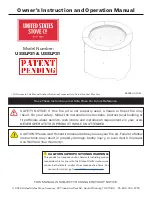
INSTALLATION INSTRUCTIONS
Preliminary Notes Before Installation
This is a High Efficiency, Flueless, Inset Live Fuel Effect appliance. It provides radiant and con-
vected warmth both efficiently and safely utilising the latest type catalytic converter burner tech-
nology.
This fire incorporates a combustion monitoring system (Oxygen Depletion Sensor). It must not
be adjusted or put out of operation. If replaced then manufacturers original parts must be used.
The fire is designed to fit various types of situations as listed in the Installation Requirements.
This appliance must be installed in accordance with the rules in force and only used in a suffi-
ciently ventilated space. A minimum of 100cm
2
(15.5 in
2
) purpose provided ventilation is
required for this appliance, an openable window or louvre is also required. This appliance is fac-
tory set for operation on the gas type, and at the pressure stated on the appliance data plate.
The room size should be a minimum of 30m
3
(1059ft
3
) to allow adequate circulation of air and
ensure the correct operation of the fire when installed in a living room. This volume may include
adjacent spaces but these spaces must not be separated by a door. In order to convert from cubic
feet (ft
3
) to cubic metres (m
3
) divide the room volume (in ft
3
) by 35.3. This appliance is intended
as a secondary source of heat only, and should not be used in a room without some form of back-
ground heating present.
The appliance must not be installed in a bedroom, bathroom or any sleeping area. The appli-
ance does not require a flue system of any type as the catalytic converter cleans the combustion
products to provide a complete combustion system which is intrinsically safe.
The appliance must be installed by a competent person in accordance with Gas Safety
(Installation and Use) Regulations 1998 or rules in force. It is strongly recommended that a
CORGI registered engineer is used for this purpose as they are the only persons approved by the
HSE under the above regulations.
On initial lightup of a new appliance, the ‘newness’ smell will burn off within the first few hours
of operation. During this period some smoke may be emmited from outlet louvres, this should
be no cause for concern. Accordingly, the room should be well ventilated during this period.
Read all these instructions before commencing installation.
Summary of Contents for P30G FXL01
Page 2: ...FXL01...




































